Indiana population projections to 2050

Indiana's population growth is expected to slow as a consequence of the state's aging population.
Indiana’s population will grow by roughly 660,000 residents between 2015 and 2050—a 10 percent increase over this 35-year stretch—according to new population projections released by the Indiana Business Research Center. Growth over this period will be heavily front-loaded, with 60 percent of these gains taking place by 2030. All told, the state’s population total will climb from an estimated 6.61 million residents in 2015 to 7.27 million in 2050.
These latest population projections—which are an update to our last round of projections published in 2012—fully incorporate the dramatic shifts that have occurred to Indiana’s population trends in the wake of the Great Recession.1 For instance, due to a sharp slowdown in migration and a drop in fertility rates since 2010, the projected total for Indiana’s population in 2020 is roughly 114,000 residents lower than it was in our last set of numbers. The state’s projected growth for the decade between 2010 and 2020 is less than half that seen during the 1990s and less than two-thirds as large as the growth recorded during the 2000s (see Figure 1).
Figure 1: Indiana population growth by decade, 1900 to 2050
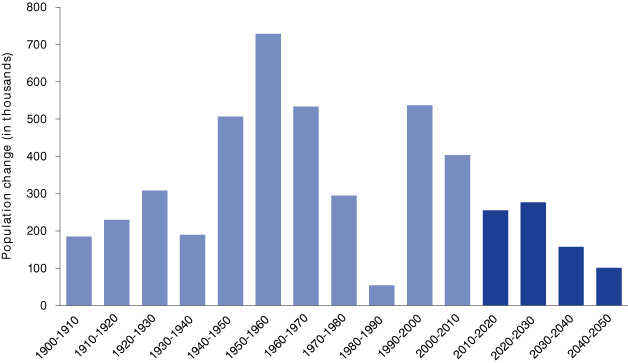
Source: Indiana Business Research Center
Indiana is projected to see somewhat stronger gains between 2020 and 2030 as migration rates and fertility rates move back toward their longer-run averages (see Figure 2). The state will continue to grow in the next two decades, although at increasingly lower rates.
Figure 2: Projected change in Indiana's population, 2010 to 2050
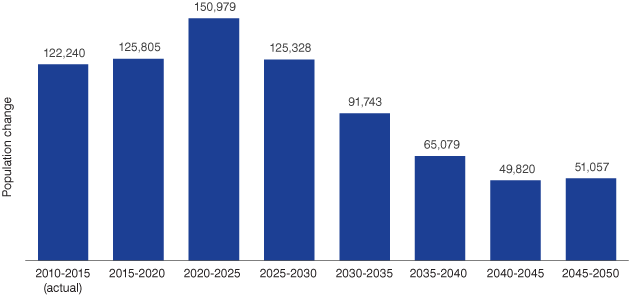
Source: Indiana Business Research Center
While total population growth has been surprisingly slow in recent years, other persistent demographic trends continue to reshape the state. Namely, Indiana will continue to grow older as the baby-boom generation ages, and just a handful of metropolitan areas will be responsible for most of the state’s population gains. This article summarizes the key findings from these population projections and highlights the key demographic trends that will transform the state in the coming decades.
Indiana’s aging population
One demographic trend that is certain to play out over the next two decades is the aging of Indiana’s population. In 2018, baby boomers are between the ages of 54 and 72, and the youngest boomers will be 71 in 2035. As this cohort ages, the share of Indiana’s population that is age 65 or older will jump from 14.6 percent in 2015 to 20.7 percent in 2035 (see Figure 3).
Figure 3: Projected share of total population by age group, 2015 to 2050

Source: Indiana Business Research Center
All other major age groups will see their share of total population decline over this projection period. The 45-to-64 age group, for instance, will drop from 26 percent of the state’s population in 2015 to about 23 percent in 2035 as baby boomers age out of this class. This drop in relative terms translates into a decline of roughly 120,000 residents in the 45-to-64 age group over this span (see Figure 4).
Figure 4: Indiana population by age group
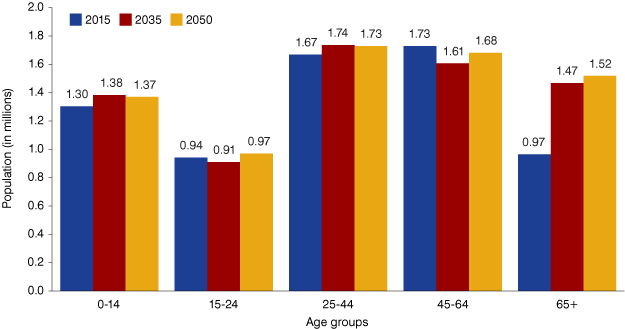
Source: Indiana Business Research Center
While the decline for this age group over the next two decades is offset somewhat by an increase in the 25-to-44 age group of 67,000 residents, Indiana’s traditional working-age population is set to decline some over the next 20 years. Between 2035 and 2050, however, the number of Hoosiers between the ages of 25 and 64 should climb again, increasing by 2 percent over this stretch.
Another significant consequence of Indiana’s aging population is that as the state becomes older, population growth will slow. That is, there are two demographic forces that drive population change: migration and natural increase (the difference between the number of births and number of deaths). Migration is an important driver of population change, but natural increase has traditionally accounted for most of Indiana’s population growth. For instance, these projections show Indiana adding nearly 126,000 residents between 2015 and 2020, with natural increase responsible for 88 percent of this increase. Even during periods when the state saw strong net in-migration like the 1990s, natural increase accounted for approximately 60 percent of the state’s population growth.
The number of births in Indiana should climb over the next 10 years but then hold relatively flat for the next two decades before beginning to rise again. Meanwhile, the number of deaths in the state will increase from about 63,300 per year between 2015 and 2020 to 85,500 per year between 2045 and 2050. Comparing these same periods, the natural increase of Indiana’s population is projected to fall from approximately 22,200 residents per year to 5,400 annually (see Figure 5).
Figure 5: Projected number of births, deaths and natural population increase
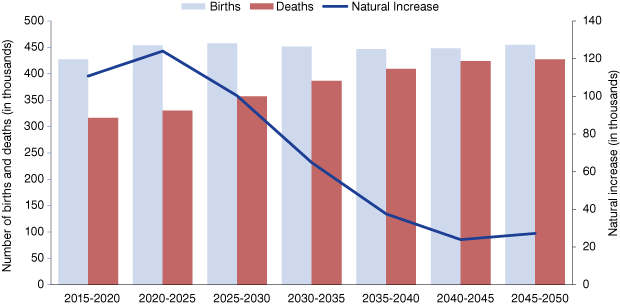
Source: Indiana Business Research Center
When thinking beyond the year 2050, it is encouraging to note that the projected slide in Indiana’s natural increase is expected to end during the 2040-to-2045 period, with a slight uptick in this measure expected over the next five-year span. So natural increase will continue to be a source of population growth in Indiana, and will likely grow steadily, though slowly, in the second half of this century.
Sharp disparities in growth among Indiana counties
Indiana will continue to grow over the next 35 years, but the state will likely see wide differences between a relatively small number of mostly metro-area communities that will fuel this growth and a large number of mid-sized and rural communities that are projected to see population declines. Between the years 2000 and 2010, 63 of Indiana’s 92 counties saw an increase in population. The number of counties to add residents between 2010 and 2015 fell to 35, according to U.S. Census Bureau estimates. These projections indicate that only 33 counties will see a population increase between 2015 and 2050 (see Figure 6).
Figure 6: Projected population change by county, 2015 to 2050
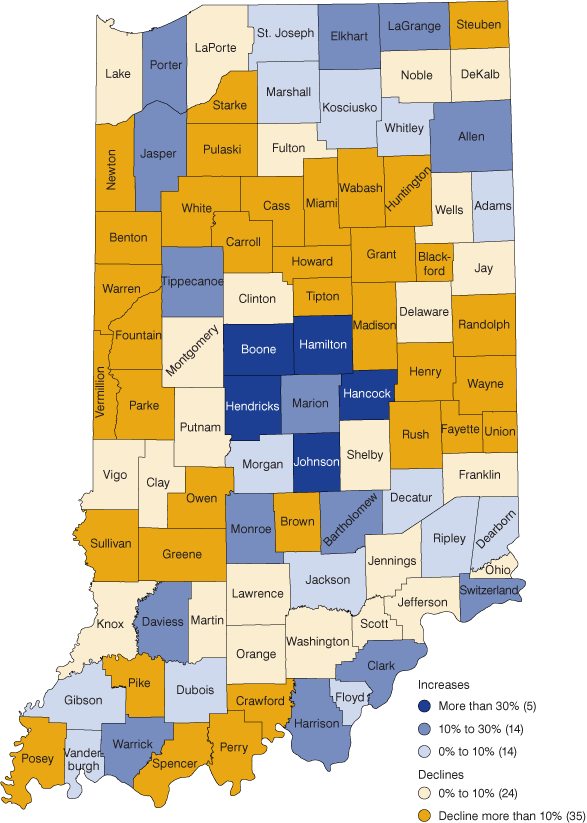
Source: Indiana Business Research Center
The Indianapolis metro area will continue to be the state’s primary source of population growth over the coming decades. This 11-county region is projected to see its population climb from 1.99 million residents in 2015 to 2.51 million in 2050—a 26 percent increase. As this region adds more than half a million residents over the next 35 years, its share of Indiana’s total population will rise from 30 percent in 2015 to nearly 35 percent in 2050.
Hamilton County will lead this metro (and the state as a whole) in growth, with an increase of more than 218,000 residents. Over this stretch, Hamilton County will likely overtake Allen County and Lake County to become the state’s second most populous county with a total of approximately 528,000 residents in 2050.
Hamilton County will not be the only community in the Indy metro expected to see rapid growth. In fact, the five fastest-growing counties over this projection period will be suburban communities in this region. Boone, Hendricks, Johnson and Hancock counties will each see their populations grow by at least 33 percent by 2050. Outside of Central Indiana, the other communities that are projected to grow by at least 20 percent by 2050 are Tippecanoe, Daviess, Monroe, Clark, Elkhart and Switzerland counties.
Looking at Indiana’s largest communities, Marion County will add 128,000 residents by 2050 to reach a total population of nearly 1.07 million people—a 14 percent increase. Allen County will continue to see strong growth, with an 18 percent increase over the next 35 years and a population of 434,000 residents at the midpoint of this century. St. Joseph County will see a modest gain of approximately 2,500 residents during the projection period. Among Indiana’s 12 largest counties, only Lake County—which is projected to decline by 3 percent to a total of 473,000 residents in 2050—will see a drop in population.
While the state will have a number of fast-growing communities over the next few decades, most Indiana counties will likely see a decline in population during this projection period. Losses will be especially common among Indiana’s mid-sized and rural communities. As Figure 7 highlights, the 44 Indiana counties that are part of a metropolitan statistical area will combine for a 15 percent increase in population between 2015 and 2050. Meanwhile, the state’s mid-sized communities—or micropolitan areas (meaning counties with a city or town that has a population between 10,000 and 50,000 residents)—will have a 6 percent drop in population, and Indiana’s rural counties will combine for a 9 percent decline by 2050. All told, 59 of Indiana’s 92 counties are expected to see population losses over the next 35 years.
Figure 7: Projected population change by county type

Source: Indiana Business Research Center
The reason for these widespread declines is twofold. First, in recent years, most Indiana counties have had a net out-migration of residents. Between 2000 and 2010, for instance, the IBRC estimates that 62 counties in the state had more people move away from the county than move in. Yet, over the same period, only 29 counties lost population, meaning that 33 counties had enough natural increase over the decade to overcome the net outflow of residents and post population gains.
These projections suggest that most counties will continue to have a net out-migration, but as the population ages, fewer and fewer counties will have enough of a natural increase to make up the difference. In fact, a growing number of counties will show a natural decrease of their population in the coming decades (i.e., more deaths than births). Data from the Indiana State Department of Health indicate that 27 counties in Indiana had a natural decrease in 2015. These projections show that as many as 71 counties could have a natural decrease by 2050. As a result, many of the state’s mid-sized and rural communities will continue to age rapidly, while only a few of Indiana’s metro areas will draw in young adults and families (see Figure 8).
Figure 8: Projected population change by age group and county type, 2015 to 2035
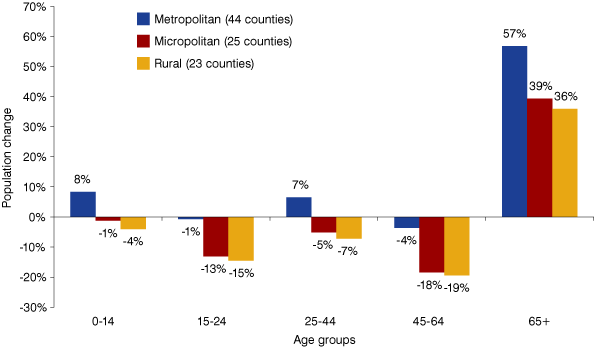
Source: Indiana Business Research Center
The easiest way to compare aging in counties or states is to look at the median age. In 2015, Indiana’s median age of 37.6 was slightly younger than the U.S. mark of 37.8. The median age in Indiana is projected to creep up to 39.9 in 2040, and then hold at that level for the remainder of the projection period. While Indiana is a relatively young state, 59 of its counties had a median age of 40 or higher in 2015. The number of counties with a median age of at least 40 will jump to 75 in 2050 (see Figure 9).
Figure 9: Projected median age of the population by county, 2050

Source: Indiana Business Research Center
About the data
The IBRC’s projections are purely demographic, meaning that they rely exclusively on recent birth/death data and migration estimates. Therefore, these figures are a reflection of what Indiana and its communities will look like if past trends continue. No assumptions have been made about future economic conditions or land use decisions.
Also, some population dynamics can be difficult to project. Migration, in particular, is prone to sudden swings. Therefore, long-range projections can be subject to significant error and it is often useful to pay greater attention to trends during the first 15 to 20 years of the projections period.
To access the entire population projection data set or to read a detailed methodology, visit the STATS Indiana Population Projections topic page at www.stats.indiana.edu/topic/projections.asp.
Notes
- Matt Kinghorn, “Slowing Population Growth,” InContext, May-June 2016, www.incontext.indiana.edu/2016/may-jun/article3.asp.
